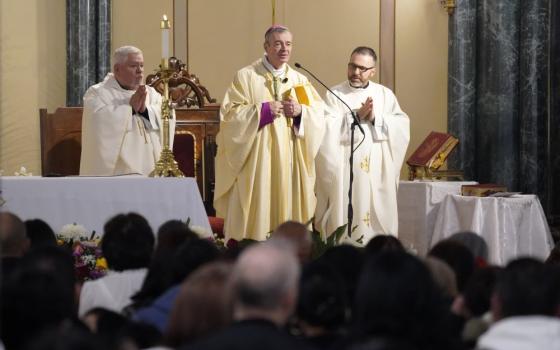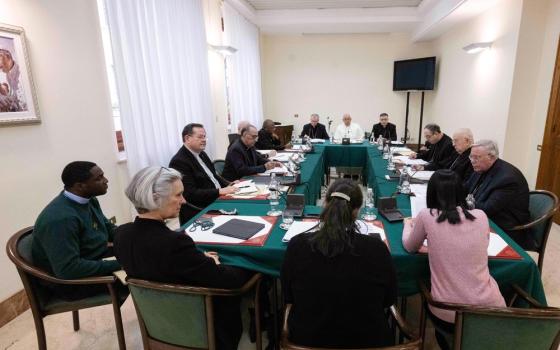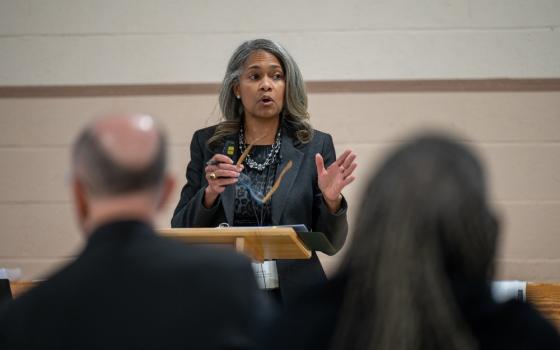
DOUALA, LITTORAL PROVINCE, CAMEROON -- The Self-Help Training Center for Prisoners and Ex-Prisoners was designed for prisoners in and from the New Bell Prison in Douala to break the cycle of repeated criminal behavior. It aims to help inmates acquire self-reliant skills while in prison so that they can lead useful, productive lives upon their release.
The Sisters of St. Therese of the Child Jesus, who initiated this project in 2003, are devoted to the care of the poor. A priority work of mercy for their congregation is prison ministry.
Prison Living Conditions
The New Bell Prison in Douala is a high security prison, which was built to house 800 prisoners, but now houses approximately 3,500 inmates: 150 women, 150 juveniles and 3,100 men. Of this number, over 2,800 are awaiting trial -- some have been waiting for more than 5 years. The prison has a recidivism rate of 30 percent within the first six months to one year of their release. Most are imprisoned for six months to a year -- a time long enough to lose one's job but not quite long enough to learn a trade while in prison.
While some people are hardened criminals, many are street youth from poverty backgrounds, deprived of good moral upbringing, and unable to read or write. Having nowhere to go upon their release from prison and with no job skills, they return to the streets and eventually find their way back to prison.
The living conditions of the prisoners are deplorable. Most have no beds, so they sleep on the bare floor. They are served only one meal of boiled corn a day. Because of crowded conditions, most go for weeks and even months without bathing. All this leads to poor health and -- because there is little or no medical treatment -- results in diseases such as tuberculosis, diarrhea, scabies, and other skin infections. Also common in the prison is HIV/AIDS.
Moreover, most of the prisoners have been abandoned by family members and friends. Lack of good reading material and productive activities contribute to an atmosphere of boredom and hopelessness. With absolutely nothing to do, the prisoners often get into fights and learn a lot more about crime than they knew before.
A New Start
The Sisters of St. Therese of the Child Jesus found a way to help prisoners convert to a new lifestyle through the initiation of a rehabilitation center. The goal is to reduce recidivism among prisoners and ex-prisoners through three objectives:
- To provide skill training for the prisoners in tailoring, knitting, and shoe repair
- To provide a small reward for work done after they acquire skills
- To accept ex-prisoners in the rehabilitation center after their release from prison where they can continue skill acquisition as well as moral, psychological, and spiritual growth
Inside the New Bell Prison two rehabilitation centers were established: one for men and one for women. Through funding from the British Embassy, construction of the In-house Rehabilitation Center began in 2003. An old toilet was converted into a workshop for women, and a second workshop for men was constructed. With the help of the Italian Bishops Conference, the rehab center itself was completed in 2004. Finally, with the purchase of equipment through a grant from the Conrad N. Hilton Fund for Sisters, the program was ready to begin:
- Inmates skilled in construction were identified to train unskilled inmates. (Skill levels were determined through a basic skills test.)
- A training period was determined (6 to 24 months) and a time table for the work program was drawn up with input from the prisoners to suit their schedule.
- Various registers were purchased to record inventory of equipment and consumables, as well as attendance, products, and deliveries.
- A leader and assistant were identified from the ex-prisoner population and other responsibilities were shared by the inmates.
- A skilled tailor was hired for six months to train inmates how to use industrial machines. Then the trained prisoners trained other prisoners.
- A non-prisoner staff person was employed to coordinate the activities for the center and to do odd jobs such as buying materials, arranging machine repairs, delivering produce, and seeking contracts for tailoring projects such as school uniforms.
- Proceeds from the work of the prisoners were used to buy medication for the prisoners and to provide a token for trainers and trainees based on attendance and personal output. Other proceeds were used or reserved as capital for the continuity of the program.
The program is supervised by the prison superintendent, social worker, and project coordinator. More than forty of the 3,500 prisoners per year take advantage of this opportunity to develop a more self-reliant way of life.
Some ex-prisoners, especially those who lost contact with their families, requested help for continued assistance after their release from prison. Hence, a second center, Yassa Douala Rehabilitation Center (YDRC), which can house up to 10 ex-prisoners, was constructed in 2006. Funding for the construction came from the Italian Bishops' Conference and some of the furniture and equipment was purchased through a second grant from the Conrad N. Hilton Fund for Sisters in 2007.
Admission to the center is by application, which pre-supposes a desire and willingness to change and do something positive with their lives. The duration of stay extends from six months to two years. During this time the ex-prisoners can be trained in tailoring, knitting, baking, and computer literacy. The ex-prisoners also profit from a formation program in human and moral development. Those who are apt are employed as workers and paid a salary.
The first ex-prisoner was accepted in 2006 before the building was finished. Some of the ex-prisoners live in the center itself and some live outside the center and come to the center for work or skill acquisition. The rehab center is managed by the project coordinator and the house master.
Winning Support for the Program
First and foremost was the need to secure the support of the prison administration. While they accepted the idea, they had doubts about its chances for success.
Best chances for winning the support of the prisoners was through personal contact. To this end, a series of meetings were scheduled: 1) group meetings for church-going prisoners were arranged after their Sunday Mass, 2) group meetings were offered specifically to the women prisoners, and, 3) one-on-one contacts were offered to anyone interested.
Each year, about 70 prisoners have been directly involved in the program. About 700 to 1,000 prisoners are indirectly involved through their contacts with the core group, given that each prisoner may have a ripple effect on about 10 or more others. Proceeds from the workshop are used to cover part of the cost of medication for the prisoners and at least once a year food is purchased to feed everyone in the prison. This provides a good opportunity to promote the program to the entire prison population.
The Project Staff
At the start, two full-time and three part-time staff provided the in-house prison services. Those who received training passed their training on to others. The current staff consists of:
- A full-time project coordinator manages all the activities in the prison.
- A non-prisoner full-time staff member serves as assistant to the project coordinator.
- Three part-time trainers (prisoners or non-prisoners) provide training in baking, sewing T-shirts and sportswear, knitting, and shoemaking.
- Volunteer nurses consult with the project coordinator about the medical needs of the prisoners.
Two full-time staff serve in the rehabilitation center for ex-prisoners:
- The project coordinator manages the center, keeps contact with prisoners interested in the rehab program and accepts them upon their release. This person contacts the family and friends if any, organizes the medical care of the prisoners, draws up identification papers of ex-prisoners, conducts support groups, and accompanies the ex-prisoners, assisting them with training, feeding, employment, and moral/spiritual development.
- A house master who lives in the center: welcomes ex-prisoners after they are interviewed by the project coordinator, coordinates all the activities at the center including prayer gatherings, teaches classes in literacy, moral development, and religion, and seeks contracts for work orders.
Factors That Contributed to Success
Due to the deplorable conditions of prison life, this project was badly needed. Because the project appealed to the needs of the prisoners they responded with interest. Moreover, they were involved from the start in the original idea and in the initial preparation. Other factors that contributed to the success of the program were:
- Having a clear vision as well as short-term and long-term goals
- Being flexible--knowing when and how to approach situations
- Being creative--finding new ways and approaches to problem solutions
- Believing in themselves--being able to sell their idea to others and having the self-confidence to convince others that the ideas were workable
- Establishing sustainable financial structures, customers, and purchasers
- Acquiring the financial support needed for starting and expanding the program
- The British Embassy helped to construct the rehab centers inside the prison
- The Italian Bishop's Conference helped with the construction of the rehabilitation center for ex-prisoners
- The Conrad N. Hilton Fund for Sisters paid for equipment and salaries for the first two years of the project and also supported the purchase of equipment and furniture for the expansion of the project to include a rehab center for ex-prisoners
- Allowing the time needed to let it take root. Sr. Jacqueline Atabong, founder of the project, believed that having the same leader for the past five years was significant. Sr. Jacqueline noted, "When the time comes to transfer leadership for the project, we intend to handle this properly by having the individual work for a reasonable length of time with the outgoing leader and ensure that contacts for the project are continued and maintained."
Challenges That Were Overcome
Because ill-health of the ex-prisoners can become a major expense for the rehabilitation center, and because some of the ex-prisoners may be HIV positive and/or have diseases that need long-term treatment, it became necessary to require a complete medical check-up--paid for by the center--before they could be admitted to the YDRC.
Because prisoners and ex-prisoners have a high level of need, psychologically, spiritually, socially, legally and educationally, it takes a great deal of courage, determination, tact, a balanced personality, and a strong faith in God to work successfully with them. Team work is very important in making this a successful venture.
There are few people who are willing and ready to work with prisoners and ex-prisoners. The work is very difficult and requires training, skill, self-confidence, and a high level of motivation. This challenge is being dealt with by:
- Identifying and training mature personnel to attend to the needs of the inmates
- Forming support groups to boost the morale and confidence of the workers
- Developing a team-work approach to caring for the in-mates, having different people attend to different needs.
- Educating the community and families of in-mates and encouraging their involvement in this project
Sustainability Measures
The project was first discussed with the Superior General and Council of the Sisters of St. Therese of the Child Jesus to gain their approval and to ensure continuity of the project through future sister appointments. It was also very important to secure the support of the Prison Administration through a written agreement that included: 1) specifics about work conditions in the prison, and 2) a statement that proceeds from the prisoners' work be used to benefit the inmates. This helped to give the project the stability it needed to take root.
To ensure financial and economic sustainability every attempt has been made to:
- Continue to have trained inmates with longer prison sentences to pass their skills on to other inmates
- Sensitize potential customers (sisters, priests and administrators of schools, colleges, hospitals and other institutions) to contract for our tailoring services
- Maintain a good customer base by doing good work, using quality materials, offering affordable prices, and providing prompt delivery of service
- Operate within a realistic budget by including all expenses in the selling price of products being sold plus a small profit to help grow the business
A good system of evaluation ensures that all components of the program are working well:
- stock inventory
- clear records of production and delivery
- proper accounting and auditing procedures
- quality control of products
- customer assessment
- annual report with audited account
A project such as this seeks to find people who are committed to serving the lost, the least, and the last. Climbing this humanitarian peak to convince the hopeless that they can change and that they can contribute, requires persistence and a sustaining faith in God and humanity.
Those who have been helped have testified that they have been given the hope and courage needed to face the challenges that lie before them. Yes, a mountain has been climbed here only to reveal higher peaks yet to climb. As Churchill once said, "This is not the end. It is not even the beginning of the end. But it is perhaps the end of the beginning."
*****
Taken from Seeds of Hope: Sisters in Action Around the World © 2009, sponsored by the Conrad N. Hilton Fund for Sisters and used with its permission. All rights reserved.
For more information about the program or about Seeds of Hope Seeds of Hope: Sisters in Action Around the World, contact: the Conrad N. Hilton Fund for Sisters, 10100 Santa Monica Blvd. Suite 1000, Los Angeles, CA 90067-4011 USA. Telephone: 310-785-0746 / Fax: 310-785-0166 / E-mail: info@hiltonfundforsisters.org. Web site: www.hiltonfundforsisters.org.



